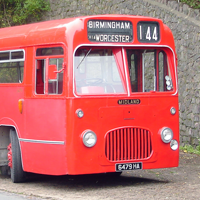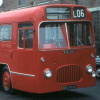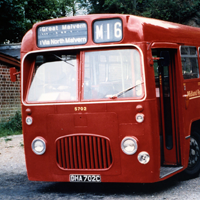Midland “Red” Motor Services (BMMO & MROC)
BMMO S17 — Overview
Introduction
In August 1961, the maximum length for single-deck buses and coaches in the UK was increased from 30′ 0″ to 36′ 0″, and maximum width increased from 8′ 0″ to 8′ 2½″. BMMO quickly took advantage of this potential increase in passenger capacity by introducing the BMMO S16 in April 1962, basically an enlarged version of the BMMO S14, with a seating capacity of 52. However, the BMMO S16 was not successful as it retained the manual gearbox and 8.025-litre engine from the BMMO S14, and was therefore underpowered with the increased weight and unpopular with staff. In response to this, the company introduced the BMMO S17 in 1963 that was similar in appearance to the BMMO S16, but featured the BMMO 10½-litre engine and four-speed SCG semi-automatic gearbox from the BMMO D9 double-deck service bus.
Note: For the younger generation…
For vehicle length, 30′ 0″ approximately equals 9m 14½cm,
and 36′ 0″ approximately equals 10m 97¼cm.
For vehicle width,
8′ 0″ approximately equals 2m 43¾cm, and 8′ 2½″ approximately equals 2m 50cm.
Production Vehicles
5446–5511 (R/Nos: 6446–6511HA)
The first batch of 66 vehicles had their bodywork finished either by Plaxton (fleet numbers 5447–5461), or by Willowbrook (fleet numbers 5462–5511), and entered service between August 1963 and May 1964. Disc brakes were fitted to the front and rear and the suspension was of the rubber type, the same as fitted to the BMMO S14, BMMO S15 and BMMO S16.
In service, disc brakes at the rear proved to be unsuccessful due to excessive pad wear and were later replaced with drums. The retention of front disk brakes at least meant these buses would stop if not quite as well as previously.
5546–5645 (R/Nos: AHA146B–195B & BHA596C–645C)
The second batch of 100 vehicles had a similar specification to the first batch, the only difference being that these vehicles were fitted with drum brakes at the rear from new. Bodywork was again finished by Plaxton (fleet numbers 5547–5571), and Willowbrook (fleet numbers 5546 and 5572–5645), and these vehicles were delivered to the depots from August 1964 to April 1965.
5675–5773 (R/Nos: CHA675C–700C, DHA701C–724C & EHA725D–773D)
The third and final batch of BMMO S17 buses built consisted of 99 vehicles, although BMMO initially classified three examples of the batch as type S21A and used them for development work.
With the exception of the three vehicles built as type S21A, specification for the third batch was much the same as for the second batch; however, shortly after production began legislation changed and all but the first few examples of the batch were fitted with front indicators just below the windows. Deliveries to the depots were from July 1965 to September 1966, and the majority of the batch had their bodywork finished by Plaxton, but BMMO finished six examples (fleet numbers 5756–5761) in-house at Central Works.
During the construction of the third and final batch, three vehicles, numbers 5722–5724 (registration numbers DHA722C–724C), were used for development work and classified as BMMO S21A from new. These vehicles were mechanically identical to the BMMO S17 but each featured 48 coach seats with headrests, and each vehicle had the seating finished different colour schemes to test public opinion. Bodywork was to the basic BMMO S17 design but painted in red and black BMMO coach livery. In December 1967, BMMO reclassified the vehicles to BMMO S22, then to BMMO S17 in July 1970 when they were fitted for one-man operation. All three vehicles were re-seated to B52F in the 1970s.
Summary
The type S17 was a very successful design for BMMO as a powerful and reliable service bus. Conversion to one-man operation started in 1966 and the S17 was ideally suited for this role. At this time seating capacity was reduced to either 44 or 48 with the inclusion of luggage pens, however all were re-seated back to 52 in later life.
On the 3rd December 1973, a number of type S17 buses allocated to depots in the Birmingham area came under the control of WMPTE who operated them with the original BMMO fleet numbers, later repainting them into dark blue and cream WMPTE livery. Of the vehicles that survived with BMMO, most saw a full 12 years service with some of the first batch being re-certified for a second time to extend their lives to over 15 years.
Withdrawals began from mid-1975, with the last two type S17 buses surviving with an Engineering float allocation until November 1979. The last two withdrawals were fleet number 5490, (registration number 6490HA) which was withdrawn from service at Worcester (Padmore Street) depot, followed a few weeks later by 5479 (registration number 6479HA) being withdrawn from Shrewsbury depot. Despite the relatively large numbers of BMMO S17 buses built, only two are known to survive in preservation (fleet numbers 5479 and 5767). Details of these can be found on the “BMMO S17 - Preserved” page.
Acknowledgements
Many Thanks to Mark Tunstall for providing the information on these pages.



